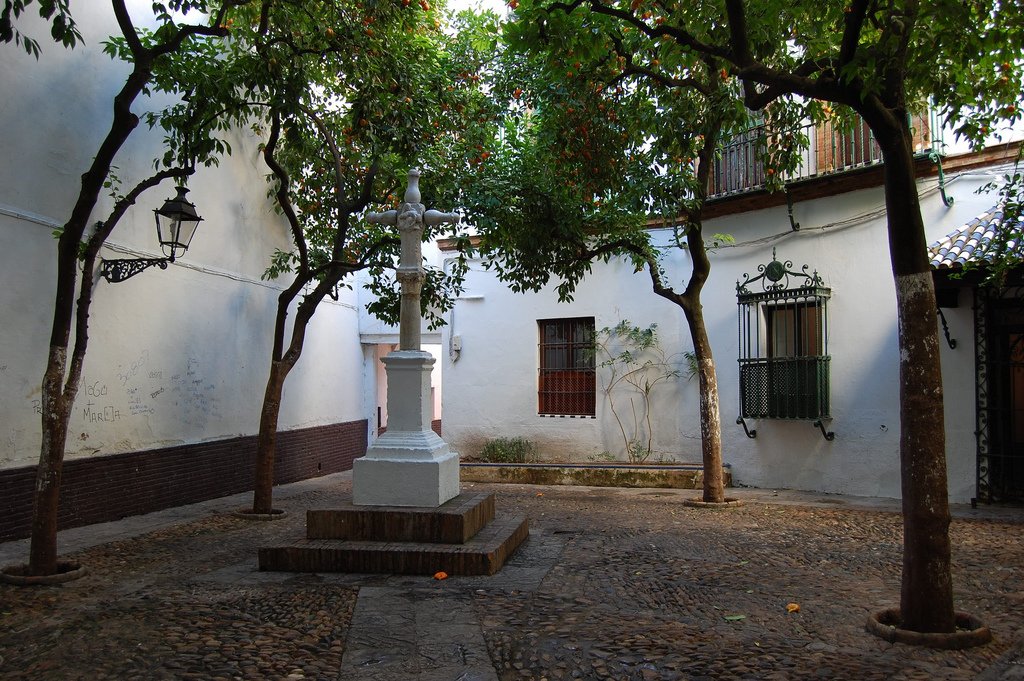
Seville is a city filled with unexplainable mysteries and conceals a large number unwritten stories within its historic walls. A city is more than its streets and monuments, it also holds the secrets and tales surrounding them. Would you like to hear some of them?
Plaza del Triunfo
This plaza was previously named the “Plazuela de La Lonja” (Market Plaza) as it was located near the Archivo de Indias building, where travellers came with their goods to sell, however it is currently known as Plaza del Triunfo. The new name is given because of a temple pavilion, “El Triunfo”, meaning ‘the triumph’ over the earthquake that took place in Lisbon in the year 1755 which is commemorated with a monument of the Virgin Mary and Child as a symbol of gratefulness for the divine protection received.
“El Triunfo” is a clear testimony that reflects what happened the day of the earthquake, however, specifically in Seville it was not considered a great natural catastrophe as it led to nine deaths in total. The legend states that those who died were fated to die for the mortal sins they had committed. Regarding the architecture, the Giralda suffered damage only on parts of the finish and ornaments, however the Torre del Oro was so damaged that many contemplated whether it should be demolished or not.
Barrio Santa Cruz
Among the narrow streets of the Barrio or neighbourhood of Santa Cruz, there is a famous street called “La Calle de los Besos” (Kiss Street). It is the narrowest street in the city and the legends that its walls hold make it a mandatory visit. Although, officially, it is called Calle Reinoso, there are various theories regarding its more commonly used and popularised name.
According to the historian Antonio Navarro Cuesta, a specialist in the history of Seville, the name “Calle de los Besos”, was given because the balconies between the buildings are very close, as narrow as just a half metre, which meant that the residents greeted each other with kisses from their balconies.
Another important street in the Barrio Santa Cruz is the Calle Gloria, where a small tile sits that says “Antiguo Rincón del Beso” which, in English, means ‘Old Kissing Corner’. It is rumoured that this corner was witness to a hidden love story. Between the Plaza de los Venerables and the Plaza de Doña Elvira, according to legend, Doña Inés de Ulloa y Don Juan Tenorio met together in secret, two characters in the Spanish play Don Juan Tenorio.
Casa Fabiola
On the street Mateos Gago in the city centre of Seville, sits the Casa Fabiola. It was previously the head office of the Lara Foundation (Editorial Planeta) and stands out for being an enormous red sided building with large wooden gates crowned with the house coat of arms. In fact, the house gives the street its name. Currently, its interior is still conserved reaching two stories high with a large patio.
Many people tell of strange noises and sensations that they feel in the hallways of the house. Various witnesses that have had the opportunity to spend considerable time there have spoken about large gusts of cold wind, lights suddenly turning off and the smell of burning wax. It is also said, that they have heard cries from a man, which, rumour has it, was one of the previous owners of the home. He was an older English gentleman who adored his Spanish home and when he finally passed away in England, it is said he did so wishing that he could have been in his old home.
Plaza de la Alfalfa
According to legend, next to the Plaza de la Alfalfa, there was a chapel that used to house dead bodies during the Roman Era. This was due to the fact that homes in that era were excessively narrow and the bodies did not fit in the houses, so families brought them to the chapel to pay their respects.
Facultad de Bellas Artes
Located on Calle Laraña, the Facultad de Bellas Artes (School of Fine Arts) building has always been known to be a mysterious building. Security guards and cleaning staff, who are the last to leave the building, tell tales of presences that call them by name or lights that switch off and suddenly turn back on or even hearing footsteps on the ceiling. Also, if there were not enough strange occurrences, a long time ago an event took place that cannot be explained and remains a mystery today. Santiago, the person in charge of maintenance at the building for many years, died in his home after finishing a work shift and the following day, in the morning, they found all of the ivy ripped off of the walls.
